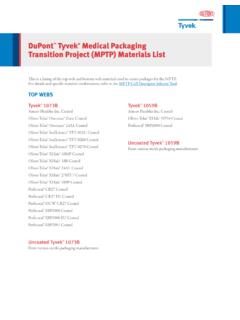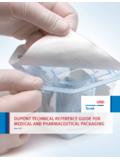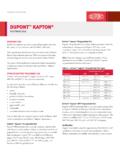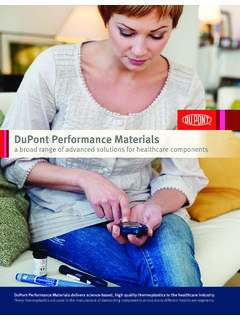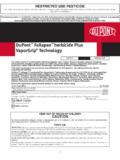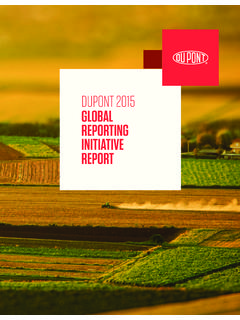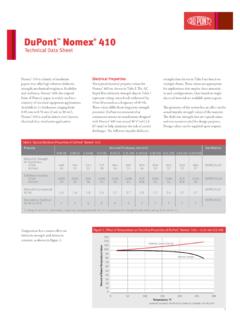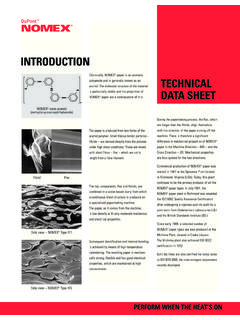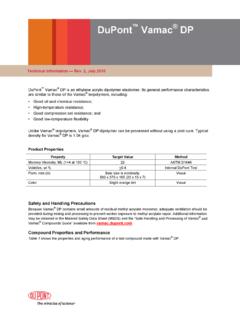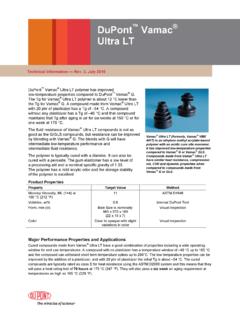Transcription of 20 STORAGE & HANDLING 21 RESOURCE …
1 INDEX1 INTRODUCTION2 PRODUCT PROPERTIES6 PRINTING ON tyvek 16 CONVERTING tyvek 20 AVAILABILITY20 STORAGE & HANDLING21 RESOURCE CONSERVATION21 CUSTOMER SERVICE22 PRODUCT INFORMATION TABLESP roduct Handbook for DuPont tyvek INTRODUCTIONINTRODUCTION 1Ty v e k brand protective material is a family of tough,durable spunbonded olefin sheet products that arestronger than paper and more cost-effective and versatile than fabrics. Made from high density polyethylene fibers, Spunbonded Olefin is an extremely versatile material, offering a balance of physical characteristics that combine the best properties of paper, film and Olefin is formed by a continuous processfrom very fine m fibers.
2 (For purposes ofcomparison, a human hair is about 75 m in crosssection.) These nondirectional fibers (plexifilaments) are first spun and then bonded together by heat andpressure, without binders. Spunbonded Olefin is strong, lightweight, flexible,smooth, low-linting, opaque and resistant to water,chemicals, abrasion and aging. Its unique combinationof properties makes Spunbonded Olefin ideal for abroad range of Choice of Hard or Soft Structure Typesfor a Wide Range of Applications Spunbonded Olefin is produced in hard and soft structure types. Type 10, a hard, area-bonded product,is a smooth, stiff nondirectional paper-like substrate withgood printability in both sheet and roll form.
3 Types 14 and 16 are soft, point-bonded products with an embossed pattern, providing a fabric-like flexiblesubstrate with good printability and tear resistance. Like Type 10, they have high opacity, excellent whitenessand good surface stability. Sewing, gluing, and, to alimited extent, ultrasonic seaming and heat sealing may be used in fabricating these 14 styles are used where barrier, durability andbreathability are required. They offer excellent splashand dry protection against particulate matter and providean excellent bacterial barrier. The unique low-linting prop-erties, combined with the barrier properties, make Type 14 an excellent material for cleanroomapparel in pharmaceutical manufacture and electronicdevice 16 styles are pin perforated with 5-20 mil ( mm)
4 Holes, giving them much higher air andmoisture permeability, additional softness, and greaterflexibility and drape than Type 14 styles, but at theexpense of lower tear strength and barrier 16 styles, when fabricated into garments, havehigher air permeability at the expense of barrier , Type 16 styles are used in disposable, general-purpose industrial garments, bags and and Antistatic Treatments Improve Adhesion, Printability and HandlingMost Spunbonded Olefin that will be printed on iscorona (discharge) treated to improve ink and coatingadhesion. This treatment oxidizes the surface andincreases the wettability of the surface to inks, coatings and adhesives.
5 This treatment lasts more than 20 reduce the buildup of static electricity during sheetand roll HANDLING operations, some styles are alsocoated with an antistatic agent. Spunbonded Olefindestined for use in the packaging of sterile medicaldevices is not corona treated nor 10 Paper-likeHard StructureArea-bondedSmooth PatternStiffTypes 14 & 16 Fabric-likeSoft StructurePoint-bondedEmbossed PatternFlexibleThe unique ability to resist air and water penetration, while allowing moisture vapor to pass through makes DuPont tyvek extremely popularfor providing protection, comfort and energy efficiency when used in residential and commercial Unique Combination of PropertiesThe physical properties common to all three types of tyvek brand spunbonded olefin combine to make them ideal substrates for many printing and converting applications.
6 OUTSTANDING CHEMICAL RESISTANCES punbonded Olefin is inert to most acids, bases andsalts. Prolonged exposure to oxidizing substances, such as concentrated nitric acid or sodium persulfate,will cause some loss of strength. Resistance to variousacids and bases; oxidizing and reducing agents; salt solutions; and organic solvents is summarized on pages DEFORMATIONE levated temperatures increase the sensitivity to tension-caused width loss and deformation. For example, Style 1073D can withstand lb/lineal ( N/cm) tension at room temperature, but at225 F (107 C), tension in excess of lb/lineal in. width( N/cm) will cause permanent DIMENSIONAL STABILITYS heet dimensions change less than between 0 and 100% relative humidity at constant REQUIREMENTSS tyles 1059B and 1073B meet the requirements of Title 21 of the United States Code of FederalRegulations (21 CFR ) for direct food contact applications (such as food packaging; desiccant, de-oxidizing agent or other active packaging; and direct contact labels) where the temperatures do not exceed 212 F (100 C).
7 FLAMMABILITYThe flammability characteristics of Spunbonded Olefin,a synthetic nonwoven material, are similar to those ofmost synthetic fibers. When exposed to a flame, Spunbonded Olefin shrinksaway rapidly. If the flame is made to follow the shrinkingsheet, Spunbonded Olefin will melt at 275 F (135 C),and if its auto-ignition temperature of 750 F (400 C) is reached, it will 10 Spunbonded Olefin is rated class A whentested in accordance with ASTM 14 and 16 are rated Class 1 Normal Flammability by the Federal Flammable Fabrics Act for ClothingTextiles (16 CFR-1610). Spunbonded Olefin does notpass DOC FF3-71, Children s Sleepwear Test.
8 *Spunbonded Olefin and laminates of SpunbondedOlefin are not intended for use in fire-retardant user should ensure that Spunbonded Olefin meets all flammability standards for the FLEXIBILITYS punbonded Olefin has outstanding flexural strengthand will easily exceed 20,000 cycles when tested on an MIT flex tester (TAPPI method T-423).LOW-LINTINGB ecause Spunbonded Olefin is composed of essentiallycontinuous fibers, it does not generate a significantamount of lint particles under conditions of ordinary WEIGHTType 10 has a density of approximately g/cc, which is only half as much as MOISTURE RESISTANCEThe physical properties of Spunbonded Olefin are not affected by water; Spunbonded Olefin is equallystrong wet or dry under ordinary conditions and ambient LIQUID BARRIER PROTECTIONS punbonded Olefin with neither corona treatment nor antistatic agent ( , Style 1073B) has a hydrostatichead in excess of 50 in.
9 (127 cm). If antistat is applied,the hydrostatic head will drop to 40-50 in. (102-127 cm).Corona treated and antistated Spunbonded Olefin ( , Style 1073D) has a hydrostatic head that is less than 15 in. (38 cm).PRODUCT PROPERTIES* Spunbonded Olefin does notmeet the requirements under the Federal Flammable Fabrics Act for Children s Sleepwear, FF3-71 and PRODUCT PROPERTIESE nvelopes made of DuPont tyvek resist punctures, tears, and moisture better than any other envelope OPACITYThe high opacity of Spunbonded Olefin is the result of multiple light refractions among the very fine polyethylene fibers and air within the densely packedsheet Olefin is one of the whitest materials available for printing.
10 The GE Brightness of SpunbondedOlefin (using the TAPPI Standard Test Method/Technidyne Instrument) is For purposes of compar-ison, a pure titanium dioxide pellet measures Colorvalue, or whiteness, is also defined by L,a,b values. TheHunterlab Model D-25 color difference meter measuresthe brightness, color components and whiteness. Thefollowing values are typical for Type 10:POROSITYC ompared with most textile fabrics, the air permeabilityof Types 10 and 14 is low. Moisture-vapor transmissionis much higher than that of plastic films and similar tothat of coated ROT & MILDEW RESISTANCEA lthough mold and mildew can grow on SpunbondedOlefin, it shows no degradation after being buried in soilfor an extended period.
